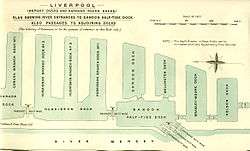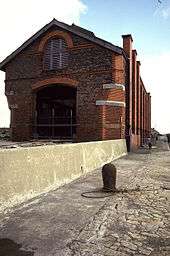Huskisson Dock
| Huskisson Dock | |
|---|---|
.jpg) Huskisson Dock seen from the north side | |
| Location | |
| Location | Kirkdale, Merseyside, United Kingdom |
| Coordinates | 53°25′54″N 3°00′19″W / 53.4316°N 3.0052°WCoordinates: 53°25′54″N 3°00′19″W / 53.4316°N 3.0052°W |
| OS grid | SJ333932 |
| Details | |
| Owner | The Peel Group |
| Operator | Mersey Docks and Harbour Company |
| Opened | 1852 |
| Type | Wet dock |
| Joins | |
| Area | 15 acres (6.1 ha), 993 sq yd (830 m2)[1] |
| Width at entrance | 90 ft (27 m) |
| Quay length | 1,122 yd (1,026 m)[2] |

Huskisson Dock is a dock on the River Mersey, England, which forms part of the Port of Liverpool. It is situated in the northern dock system in Kirkdale. Huskisson Dock consists of a main basin nearest the river wall and two branch docks to the east. It is connected to Canada Dock to the north and Sandon Half Tide Dock to the south.
History
The dock was designed by Jesse Hartley and opened in 1852. It is named after a former MP and Treasurer of the Navy, William Huskisson. Initially dealing in timber, it later traded in grain and provided berthing facilities for passenger ships on North American routes. The main basin was enlarged and a branch dock created in the 1860s to accommodate larger ships. The dock was expanded again at the turn of the twentieth century when two further branch docks were added by Anthony George Lyster.[3][4]
World War II
On 3 May 1941 Huskisson Branch Dock Number 2 was the site of the SS Malakand explosion during the Liverpool Blitz, when 1,000 tons of explosives on board the ship were ignited during an air raid. Four people were killed and debris from the ship was strewn up to 2.5 miles away. The two ton anchor stock from the ship landed outside Bootle General Hospital, Derby Road, 1.5 miles from the scene.[5][6][7]
Late 20th century
Largely destroyed by the Malakand explosion, Huskisson Dock was rebuilt after the War. Huskisson Branch Dock Number 2 was subsequently filled in and is now the site of a timber yard. Huskisson Dock remains in use, handling general bulk cargoes.[3][7]
Throughout the late 1970s the Nigerian 'river' ships (named after Nigerian rivers) were regular visitors to Huskisson Dock. The Nigerian sailors were veritable traders, loading locally purchased, second hand household appliances onto ships for sale in ports of call in Africa, en route to Nigeria.
Impounding station

The impounding station alongside Huskisson Dock was a pumping station used to maintain water levels in these 'floating' docks.
References
- ↑ Baines 1859, Part II, p. 82
- ↑ Baines 1859, Part II, p. 116
- 1 2 "Trading Places: Huskisson Dock history". Liverpool Museums. Archived from the original on 7 September 2009. Retrieved 4 May 2008.
- ↑ Pollard & Pevsner 2006, p. 277
- ↑ "The 'May Blitz' 1941". mersey-gateway.org. E. Chambré Hardman Archive. Archived from the original on 27 September 2007. Retrieved 4 May 2008.
- ↑ "Liverpool Blitz: Attacks on the docks (SS Malakand Incident)". Liverpool Museums. Archived from the original on 8 February 2005. Retrieved 21 December 2004.
- 1 2 "Huskisson Dock". Level 2: Urban exploration. Archived from the original on 27 September 2007. Retrieved 28 June 2007.
Sources
- Baines, Thomas (1859). Liverpool in 1859. London: Longman & Co. OCLC 43484994.
- Pollard, Richard; Pevsner, Nikolaus (2006). Lancashire: Liverpool and the South West. Yale University Press. ISBN 9780300109108. OCLC 63396571.
Further reading
- McCarron, Ken; Jarvis, Adrian (1992). Give a Dock a Good Name?. Birkenhead: Merseyside Port Folios. pp. 56–57. ISBN 9780951612941. OCLC 27770301.
- Woolley, Peter W. (1989). Liverpool. Volume 2: A Portrait of the Docks and River Mersey. S. B. Publications. pp. 38–39. ISBN 9781870708173. OCLC 834469835.
External links
| Wikimedia Commons has media related to Huskisson Dock. |
- "Liverpool North Docks diagram". Liverpool 2007. Archived from the original on 30 March 2007.
- Huskisson Dock aerial photo
- Photo: Huskisson Branch Dock No. 2 after the SS Malakand explosion.